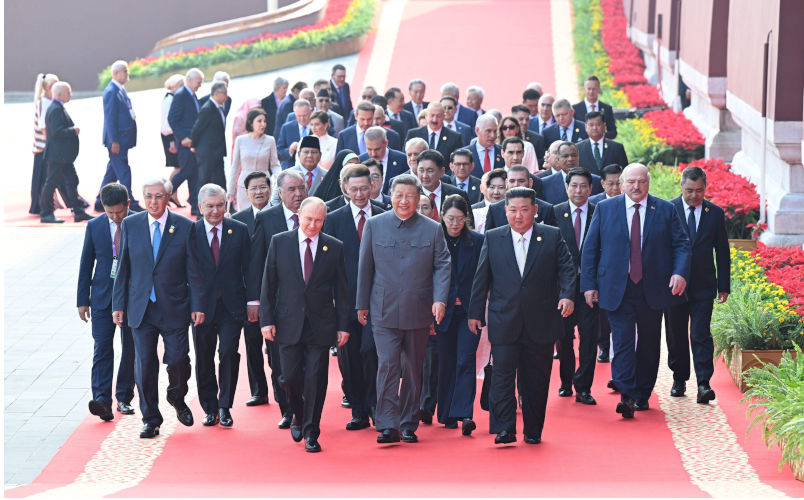China’s giant military parade didn’t surprise just the West
September 16, 2025
China’s recent display of its newly acquired military might surprised not only international observers, but also its own seasoned diplomats.
As Fu Ying, the former ambassador to Australia and the UK, told the Financial Review Asia Summit this week, she had not realised how far China’s military capacity had advanced.
She told the conference that she “really felt very proud for my country. I think such a … transparent display of strength is a strong signal to the world about the country’s determination and growing capability to prevent the return of the humiliation of the past”.
She also emphasised that its regional neighbours had attended the parade, many after participating in the Shanghai Co-operation Organisation Summit, held in Tianjin, a few days earlier. It was the Chinese Government’s view that China’s relationship with its neighbours was “at its best … in modern times”.
The Philippine Government would certainly reject this conclusion, but elsewhere, Beijing has worked hard to turn around negative views of China that resulted from its period of “Wolf Warrior diplomacy” – an act of self-harm.
Fu was at pains — both in her remarks to the summit and in private conversations — to assuage concerns about China’s startling display of military hardware. Instead, she argued that its leadership was primarily focused on internal affairs.
As in all political systems, different views prevail at different times. Fu represents more of the less abrasively nationalistic strand of China’s foreign and security policy establishment. In this, she belongs squarely in the Deng Xiaoping stream of building strength and capability while avoiding conflict.
Consistent with that, it is not surprising that she highlighted the range of domestic policy challenges Beijing must address as priorities. These included sluggish economic growth, high youth unemployment, huge local government debt, decarbonisation and deleveraging the property sector.
Although the military parade caught the world’s attention, as it was intended to do, the domestic audience was an even more important one.
Such parades are intended to burnish the leader’s authority. Not only is Xi Jinping China’s President and Communist Party general secretary, he is also chairman of the Central Military Commission. He can take personal responsibility for the dazzling display of China’s might.
This should also end the vacuous recent foreign-sourced rumours of Xi’s demise. In one week, he not only gathered many countries to the SCO meeting but also followed this up with a huge parade. The recent string of sackings of his senior military leaders, apparently for “corruption”, hardly suggests his authority is under challenge when viewed against these events.
Arguably, China already enjoys regional hegemony. And with its economy expected to continue to grow at about 5% each year for some time to come, its power and influence will rise accordingly.
We do not know what sort of hegemony China will exhibit, but it is unlikely to be one like the European colonial powers and perhaps less interventionist than the US. With the experience of Russia’s severe setbacks with its invasion of Ukraine across a contiguous land boundary, a maritime invasion of Taiwan, or even a blockade, may be out of reach for Beijing.
Beijing’s ambitions seem to be to continue strengthening its role and influence in the United Nations and to work through multilateral and regional forums to advance its interests.
The message being sent to Australian policymakers is that they must learn to live with a stronger and more confident China and manage things in the best way they can to advance their interests.
If the _Politico_ reports from Washington during the week are correct, Australia will be doing this without much support from the US. Apparently, senior Department of War officials are suggesting that homeland defence and the Western hemisphere replace China as the US’ principal threat. This would also seem to be consistent with Donald Trump’s instincts.
Fu’s observation, that there is still quite a bit of underlying tension in the Australia-China relationship, suggests that Beijing believes more can be done to improve relations.
In a quite candid comment at the summit, she said, “Some Australians gave the Chinese the feeling that they would shake hands with China on the table and kick China under the table.”
This goes to the heart of Australia’s foreign policy dilemma with China. It has always been there, but the tension between our commercial interests on one hand and our security perceptions on the other continues to grow.
Nonetheless, Prime Minister Anthony Albanese has skilfully corrected Australia’s China policy and put the relationship back on track. His recent visit to Beijing served to reinforce the message that it is back to normal. His government’s management of the relationship has been disciplined, and the megaphone diplomacy has been shelved.
It is now imperative that Foreign Minister Penny Wong has talking points retyped by the Department of Foreign Affairs and Trade to do away with the rhetoric of “stabilisation”. What is required is for Australia to recognise that it has agency when dealing with a powerful China and to begin to adopt ambitious, forward-looking initiatives that usefully advance common bilateral interests.
Fu suggested greater co-operation in health, medical science and artificial intelligence. But a forward, ambitious agenda could also include areas such as energy and decarbonisation, regional security and new avenues for regional trade liberalisation and facilitation.
These need not be exclusively between the two countries, but bilateral engagement with the major power of the region would be a good place to start. Australia once had confidence in its agency and led on many significant regional initiatives – from creating APEC, to the Cambodian peace settlement and the Bali process on people smuggling.
It is time to face the reality of Australia’s new security environment and see it as full of opportunity rather than risks.
Republished from Australian Financial Review, 12 September 2025
The views expressed in this article may or may not reflect those of Pearls and Irritations.

